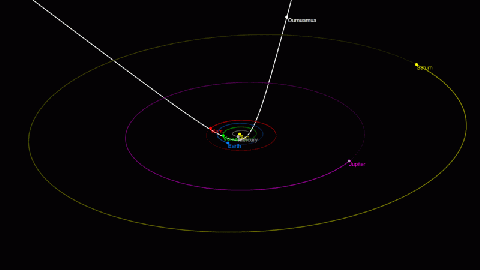What to do if the ‘Oumuamua space “probe” comes around again

- Two Harvard researchers recently speculated that an object that entered into our solar system was an interstellar probe.
- The odds that this is what happened are quite literally astronomical.
- If humans are to build spaceships to chase after the probe, we’ll need to come to a greater understanding of how to manipulate dark energy that exists in the universe.
Near the end of last year, an asteroid-like object entered our solar system, said hello to our surrounding stardust, and left. It was given the name ‘Oumuamua, which is the Hawaiian word for ‘scout.’ What made the arrival of an object like ‘Oumuamua noteworthy were three things: the angle at which it entered the solar system, the unusual speed with which it left, and the shape it would have to be for it to follow the path in which it entered into our solar system and then left. To put it more plainly: A comet doesn’t bounce off our solar system like a stone skipping across a lake.
So what happened? What was it? The headline-grabbing thing was this: Two Harvard researchers speculated that the object could have been a satellite sent from an alien civilization and that the reason why the object sped up as it made its way past the Sun was that the object was using a lightsail of some kind.
Rather than follow the path of some speculation that the object was a comet—and since, as science writer Paul Gilster noted over at Centauri Dreams, “we did not have observations sensitive enough to produce a resolved image of the object”—they opted to build their speculation on the fact that the acceleration of the object observed is “naturally produced by radiation pressure.”
There’s a reason to be cautious here: The two researchers from Harvard put the probability of their research at 20 sigma. Sigma is a reflection of certainty. For comparison’s sake, the results obtained from the Large Hadron Collider ran at 2 sigma, meaning that there was a 5% chance the results observed were a statistical error. To therefore claim that an observed event is 20 sigma either means that the math was wrong, something else went wrong, or that something extraordinary occurred.
But if we’re to assume that something extraordinary occurred—which is quite the leap in and of itself—it’s worth speculating on what we should do if the asteroid space probe comes around again.
One suggestion—as flagged by Gilster once again—is to send a craft after the asteroid probe:
The challenge is formidable: 1I/’Oumuamua has a hyperbolic excess velocity of 26 km/s, which translates to a velocity of 5.5 AU/year. It will be beyond Saturn’s orbit within two years. This is much faster than any object humanity has ever launched into space. Compare this to Voyager 1, the fastest object humanity has ever built, which has a hyperbolic excess velocity of 16.6 km/s.
So what sort of craft would it need to be? How far afield from practicable physics is that mission? Do we board the ship in space or do we use fuel to leave the gravity of Earth and then get ready to travel through space?
And what should be the method by which we travel through space? Solar sails? A wormhole? (There are three problems with floating the idea of wormhole: they collapse before someone has the chance to go through them; the wormhole is connected to a different universe, not a distant part of our universe; and we don’t know how to make a wormhole.) Through growing plants in the asteroid belt to seek to grow an eventual launch pad out on that perimeter, as Freeman Dyson once proposed? An Alcubierre drive?
What would we need to consider if we tried to make an Alcubierre drive?
The effect of an Alcubierre drive would be akin to standing on a conveyor at an airport that moved you from one place to the next. This would be achieved through something called a warp bubble. The warp bubble happens when the space behind you on the figurative conveyor at the airport expands, pushing you forward, and the space in front of you contracts towards you. This happens because spacetime is flat inside and outside the bubble but curved at the edge; the bubble almost looks like it’s been pinched.
“Please don’t fall for the hype,” Alcubierre implored a gathered audience in 2017 as he gestured at a mockup of a spaceship behind him. “We have no idea how to build this at all. We have no idea how to build a warp engine.”
One of the many reasons why people have no idea how to build a warp engine is that a warp bubble requires negative mass. You need to produce the mass equivalent of Jupiter to push a spaceship the size of a car. And while something in the universe is generating negative mass, the nature of our role in unlocking its potential remains yet to be seen.





